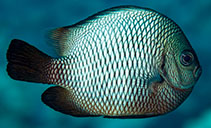| Family: |
Pomacentridae (Damselfishes), subfamily: Chrominae |
| Max. size: |
13 cm TL (male/unsexed) |
| Environment: |
reef-associated; marine; depth range 1 - 50 m, non-migratory |
| Distribution: |
Eastern Central Pacific: Hawaiian Islands and Johnston Island. |
| Diagnosis: |
Dorsal spines (total): 12-12; Dorsal soft rays (total): 15-16; Anal spines: 2-2; Anal soft rays: 15-16. Closely related D. trimaculatus, which does not occur in the Hawaiian Islands and Johnston Island. |
| Biology: |
Adults are found in very shallow, protected water, over coral and rocky bottoms. Young often sheltering among the branches of Pocillopora; occasionally commensal with the anemone Marcanthia cookei (Ref. 9710). Benthopelagic (Ref. 58302). Peak spawning from May to August. Age-at-maturity estimated at one year. Feed on zooplankton, benthic invertebrates, and algae (Ref. 9710). Oviparous, distinct pairing during breeding (Ref. 205). Eggs are demersal and adhere to the substrate (Ref. 205). Males guard and aerate the eggs (Ref. 205). Have been reared in captivity (Ref. 35412). |
| IUCN Red List Status: |
Least Concern (LC); Date assessed: 11 July 2022 Ref. (130435)
|
| Threat to humans: |
harmless |
Source and more info: www.fishbase.org. For personal, classroom, and other internal use only. Not for publication.

